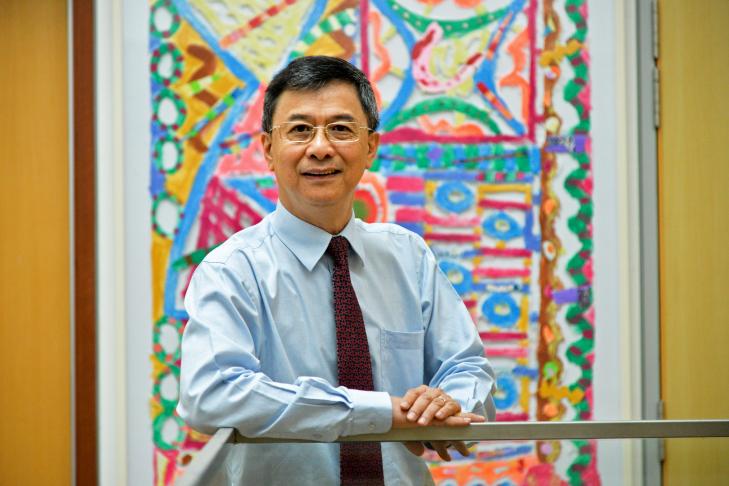
How does an economy stay healthy and keep on growing? SMU Professor Hoon Hian Teck takes a macroeconomics approach to address these questions.

Photo Credit: Cyril Ng
By Rebecca Tan
SMU Office of Research (22 Sep 2014) – Starting out at just 20 percent of the United States (US) standard of living at independence in 1965, the small island nation of Singapore has achieved impressive economic growth, reaching parity with the US in less than 50 years. Although Singapore’s Gross Domestic Product (GDP) per capita has witnessed healthy growth, it has nonetheless met with occasional setbacks, most notably the recessions of 1985 and 2008.
In his research, Professor Hoon Hian Teck from the SMU School of Economics studies both the big swings in economic activities—such as Singapore’s dramatic advancement from third to first world standard of living—as well as short-term business fluctuations commonly known as recessions or economic booms. He asks questions like what makes economies grow and has developed theories that explain why even fundamentally strong economies sometimes face economic woes.
“You could frame these questions using the analogy of the human body: understanding big swings in economic activity such as steady rises in standard of living is like studying why certain people are healthy or not, while understanding short-term fluctuations is akin to studying how even healthy people sometimes catch the flu,” he explains.
Explaining Singapore’s success story
When he began his PhD work in 1986 under the supervision of the 2006 Nobel Prize winner Professor Edmund Phelps, France had a double-digit unemployment rate, up from about three percent in the 1960s. However, Singapore had seen the reverse trend, with unemployment rates falling from close to ten percent in 1966 (the year data was first available), to three percent just before the 1985-86 recession.
Keynesian theory—the then prevailing theory—stated that unemployment rates were related to the level of aggregate spending in the country. This suggested that boosting the money supply would increase spending, which in turn would cause firms to hire more people to increase their production.
“But [Keynesian theory] wasn’t a good theory to explain Singapore’s declining unemployment rate,” Professor Hoon says. “If it was just a matter of spending, at some point, the extra spending would tend to push up prices and raise inflation. However, this theory couldn’t explain the fact that Singapore managed to bring its unemployment rate down without causing a rise in inflation rate.”
What was needed, he realised, was a new theory of unemployment that also took into account the impact of international trade on wages and the profitability of firms.
“On the one hand, an explanation involves thinking about how people make decisions about the kind of wages they would ask for, but that’s only one blade of the scissors, so to speak. The other blade is the ability of firms in the country to pay those wages and yet be profitable,” he says.
“During that era, workers were probably not too demanding in terms of the wages they asked for, as there were not many alternatives. At the same time, our ability to sell to the world market helped to push up the wages, and so, for a period of time, we were able to see the unemployment rate go down steadily without the central bank having to pump more money into the economy to boost aggregate demand. In other words, if Singapore had not chosen to be an international export-oriented country, my hypothesis is that we would not have been able to observe the steady decline in unemployment,” Professor Hoon elaborates.
1985: the tipping point
However, there is a limit to how far exports can continue to pull up wages. In Singapore’s case, that limit appeared to be productivity, Professor Hoon says.
“Even back then, we were talking about how to automate and mechanise but I think that the 1985 experience showed us that there were limits to the extent that productivity could be raised. At the aggregate level, some firms were able to succeed at readily replacing workers with machines and make a reasonable profit margin. But there were other firms that were unable to do so, and were still pressurised to raise their wages in order to hold on to their workers.”
“By 1984 or so, the cracks were beginning to show; many firms found themselves in the red. As a result, they had to close down and workers were laid off, which was why the unemployment rate shot up. What that episode showed us was that even healthy economies could not quite absorb national level efforts to push up wages, because an increase in wages might not be readily accompanied by a rise in productivity.”
Going beyond the diagnosis of the problem, Professor Hoon’s research also suggests a way forward for policy makers. Since a wage-productivity mismatch was the problem, the government sought to reduce the wage cost for employers by reducing their Central Provident Fund (CPF) contribution.
“At that time, the CPF contribution was about 25 percent for both the employee and the employer. We chose to reduce the employer’s contribution, which was essentially a wage cost, by about 15 percentage points. This led to an overall 12 percent reduction in labour cost, and helped to give breathing space to many of the firms that were struggling. Although the recession was very sharp, the recovery came quite soon—by late 1986 or so—because of these measures,” he says.
Gearing up for the future
Professor Hoon’s theories have also been able to explain Singapore’s economy under changing circumstances. For example, as Singaporeans received more education, the country’s comparative advantage in having an abundance of relatively unskilled workers decreased, leading to growing wage inequality, as predicted by his theory.
“This leaves us with two policy challenges ahead. Firstly, how to retain the distinctiveness of being economically open in such a way that wage inequalities are offset by tax transfers; and secondly, what are the sources of growth that will generate productivity growth?”
“We are at the stage where we have to create new ideas and technologies. In the 1960s, we were able to use off-the-shelf technology; we just needed to supply the manpower. Today, the situation is more challenging, hence making innovation particularly important for Singapore’s continued success,” he notes.
See More News
Want to see more of SMU Research?
Sign up for Research@SMU e-newslettter to know more about our research and research-related events!
If you would like to remove yourself from all our mailing list, please visit https://eservices.smu.edu.sg/internet/DNC/Default.aspx

